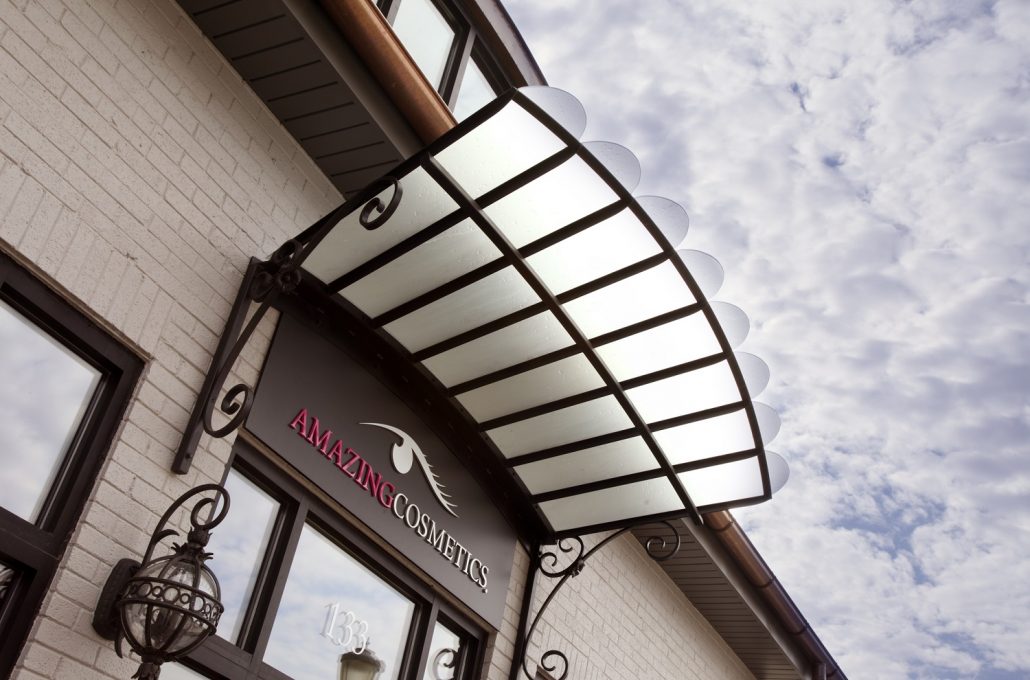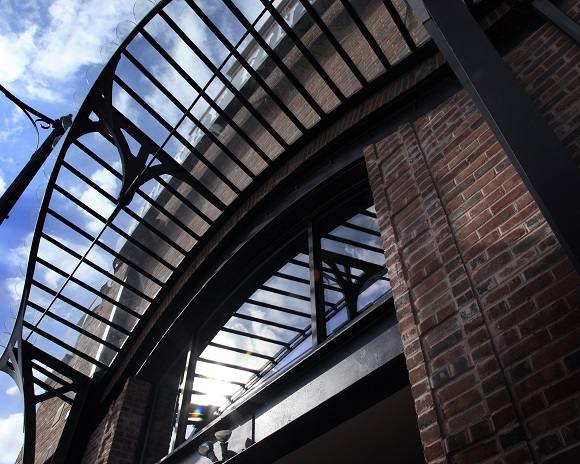Designing Ironwork

AmazingCosmetics in Libertyville IL front entrance featuring traditional eyebrow window and glass canopy to match the glamorous image of the company.
Designing ironwork to reinforce and coordinate with the design of a structure can add functional and aesthetic impact. Through the use of ironwork railings, handrails, grates, and more, we can add an element of safety to buildings and yet retain visibility and openness. Decorative ironwork elements, such as hardware, signage, and flower boxes add personality and customization to architectural projects. Consider incorporating architectural ironwork in your next building project!
Making Ironwork
Ironwork is made by forging or casting.
Forging: wrought iron is forged using fire, hammer, and anvil. Forging aligns the grains in the metal, thereby increasing its strength. Because of its inherent strength, wrought iron is often used in building projects. Take a look at the wonderful photos here to see artisans at work making wrought iron.
Casting: in contrast, cast iron is made by melting iron ore in a blast furnace and pouring the molten iron into prepared sand molds. Lodge skillets are well-known kitchen and outdoor cooking products made of cast iron. Some architectural ironwork is made of cast iron, such as finials and couplings.
Ironwork Customization

The Shanty in Wadsworth IL – custom ironwork
Ironwork is typically used for stair and balcony railings and balusters, like those created for our project at the Shanty Restaurant. In this case, the railings provide a safety barrier along the upper-level dining area and continue as a handrail along the stair. The ironwork railings also provide a sophisticated decorative element.
When we were designing this project, we knew we wanted to incorporate cathedral-like Gothic arch windows in the restaurant dining room. The wrought iron railing picks up this motif with pointed arches within the railing. Since wrought iron is easy to customize, it’s a good choice when coordinating with other important design elements.
Take a look at our design sketches below to see how pointed arches inspired us when designing the ironwork elements.
Ironwork can be successfully paired with other materials, such as glass. We can see examples of this in Libertyville at Amazing Cosmetics corporate offices and Mickey Finn’s Brewery. In both cases, the ironwork entrance canopy provides an open, decorative and functional structure. When combined with glass, it also shelters the building entrances.
When we were designing Amazing Cosmetics, we took a cue from their stylized logo design. We designed their entrance canopy to reflect the eyelash motif and to be light and feminine, like the brand.
The design at Mickey Finn’s Brewery was inspired by Belgian brewery traditions. Design elements include a stepped gable brick and exposed steel façade with an art-nouveau ironwork and glass canopy.
The handmade nature of wrought iron lends itself nicely to decorative uses. It is suitable for elaborate motifs, like hand forged ornaments and scrolls. Wrought iron sheet material can be used to make logos, letters, and numbers. These customized elements may be added to gates, light fixtures, signage, and more.
Designing Ironwork for Building Interiors and Exteriors

Mickey Finn’s Brewery in Libertyville IL art-nouveau iron canopy.
Ironwork can be used in buildings in a variety of ways for both residential and commercial/institutional projects. Stock items for building interiors and exteriors are readily available in many styles and sizes. Many of our projects require custom ironwork that is made to fit a specific commercial installation.
The finish on the ironwork will depend on the desired design aesthetic, project budget, and project location. Primed and painted is a common interior finish, while sandblasted and polyester powder coated is used for both interior and exterior metals. When hand-applied finishes are desired, the customization options are endless.
Read our blog article about wrought iron here.
The use of architectural ironwork can add an element of strength and safety to buildings. In addition, it enables us to retain visibility and openness. Architectural ironwork can be designed to add decorative impact, personality, and customization. Consider incorporating architectural ironwork in your next building project.

 © The Photographic Artwork of Jacob T. VanVooren
© The Photographic Artwork of Jacob T. VanVooren
